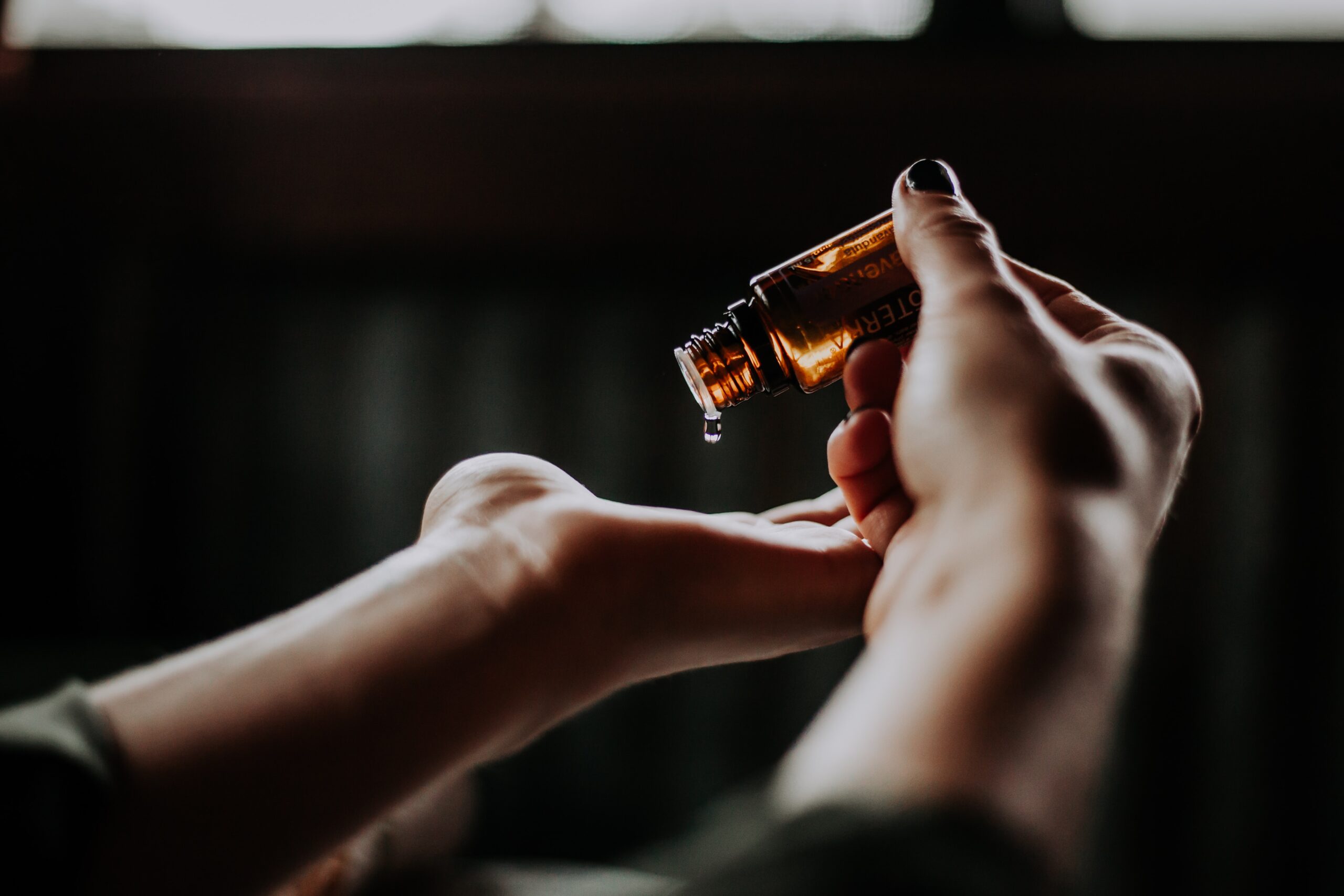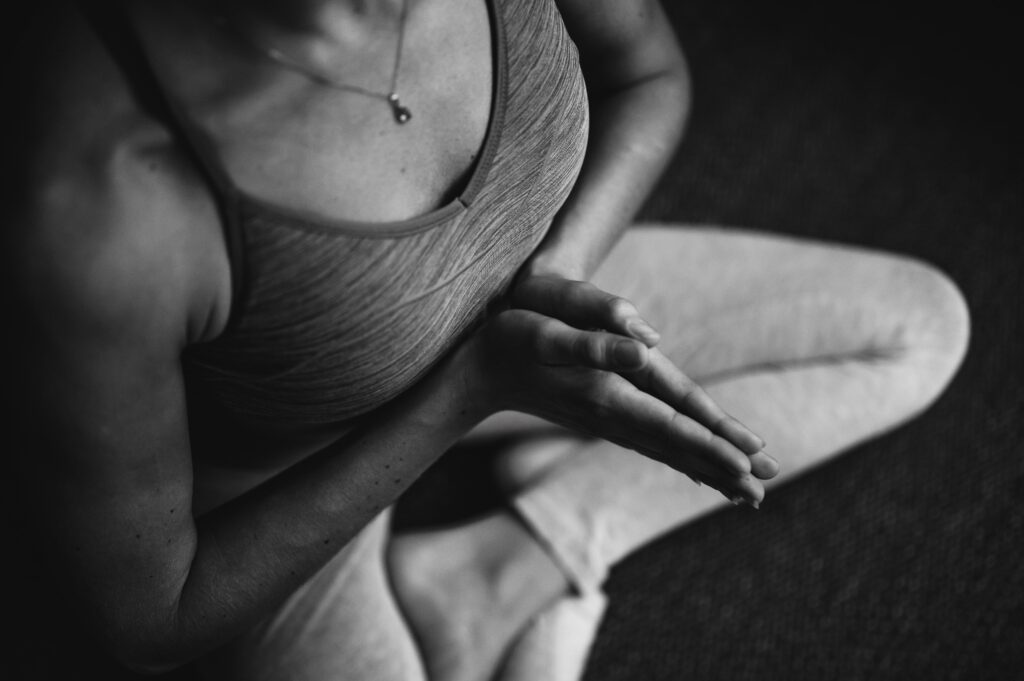While you don’t necessarily need props and mood-setting materials to establish a home yoga studio, they really can help set the stage for a deep, centering practice. Investing in your surroundings can help you create a sacred space, tune out the normal distractions of home (dust bunnies under the sofa, anyone?), and tune IN to your flow.
Here are a few suggestions that can help you get started setting up your home yoga studio – plus some to add if you’re ready to take your practice deeper.
Related: How to create a pandemic-proof home yoga practice
Yoga Mat:
While it’s possible to practice yoga without a mat, most yogis would agree: downward-facing dog is a lot easier with a grippy surface to press your hands and feet into, and savasana – the delightful few moments of rest that close each practice – is a lot more comfortable with some cushion between you and the floor.
The beauty of a home practice is that you don’t have to worry about transporting your mat, so you can feel free to layer two or more, or invest in a heavier, more padded mat without having to lug it to class with you. Here are a few of my favorites:
- Manduka Pro premium yoga mat – This mat is the foundation of my home yoga practice, and for good reason: it’s thick, supportive, and stable. Think the cushioning those tender, bony knees crave, but the density the rest of you needs to stay upright and anchored. The Manduka Pro is truly the Cadillac of yoga mats, but friends, it’s heavy – so I rarely lugged it to in-real-life class. Guess what? Now that the furthest it ever has to travel is about three feet from wall to floor, that heft is no problem.
- Classic 5 mm Gaiam Yoga Mat
 – Whether I’m in camel pose or half split – or just taking a knee to modify a lunge, plank, or twist – my knees are so very happy when I add an extra layer of padding. This relatively lightweight yoga mat used to be my go-to for toting to class; now that “class” is mostly in my bedroom, I’m layering that baby right on top of my Manduka Pro for a more comfortable child’s pose and beyond. Since the Gaiam 5 mm is a relatively light, flexible mat, it’s also really easy to quickly flip the edge over for EVEN MORE padding in frog or pigeon!
– Whether I’m in camel pose or half split – or just taking a knee to modify a lunge, plank, or twist – my knees are so very happy when I add an extra layer of padding. This relatively lightweight yoga mat used to be my go-to for toting to class; now that “class” is mostly in my bedroom, I’m layering that baby right on top of my Manduka Pro for a more comfortable child’s pose and beyond. Since the Gaiam 5 mm is a relatively light, flexible mat, it’s also really easy to quickly flip the edge over for EVEN MORE padding in frog or pigeon! - eKO Superlite Travel Yoga MateKO Superlite does have a rather strong rubbery smell (not latex – I’m talking real rubber here) that will wear off on your hands after a sweaty practice, but I’ve actually come to like the scent.
Yoga Props:
Props aren’t (always) essential, but they sure are nice. Here are a few that are staples of my home yoga practice (and some I’d like to add in.)
- Yoga Blanket – I don’t know why it took me so long to buy my own yoga blanket, since getting all warm and cozy for savasana is one of my favorite parts of class. Blankets also come in handy for modifying and propping all kinds of poses, whether you need a little extra support under your tailbone to sit in sukhasana (easy seated pose) or want to rest your forehead in child’s pose. Really, any throw blanket can work for these purposes, but I like a yoga blanket to have some heft and structure to it, like this inexpensive, colorful striped yoga blanket. One yoga blanket is nice; two are fantastic!
- Yoga Bolster – If you plan to take any yin or restorative yoga classes, a bolster (or, in a pinch, a bed pillow) is a must. Bolsters are great for modifying poses, propping, and holding resting poses for long lengths of time. I have an oblong yoga bolster like this and love its versatility. I have also looked at picking up a round yoga bolster as they seem to offer a bit more height with less width (perhaps better for back-lying heart openers?). If I was going to class in a studio, I might be afraid of a round bolster rolling away much like my water bottles always seem to, but in my home studio, it doesn’t have very far to go.
- Yoga Blocks – Sometimes the ground just feels too far away (hello, half moon.) Blocks can bridge the distance as well as support floating hips and legs in a variety of poses. If you’re just starting to think about yoga props, you can’t go wrong investing in a block or two first – they’re inexpensive and a staple of many kinds of practices, from vinyasa to yin. In my home yoga studio, I have one 4-inch yoga block and two 3″ yoga blocks which I mix and match depending on how much support I need.
Extras & Nice-To-Haves
- True confession: I do not own a yoga strap because the classes I take so rarely call for one. Regardless, every now and then I’ll run up against a bit of tightness that makes a pose difficult, and I’ll find myself wishing I had a strap to help ease the way. I’ve been thinking it’s time for me to invest in one so I can more comfortably hold dancer’s pose or cow face pose (Google it, the name mystifies me too!)
- A yoga sandbag is absolutely not a necessity, and I don’t own one, but when I practiced in the studio I loved placing them strategically on legs and hips to get a really deep, grounding stretch. If you’re going all-out for your home yoga studio, these would be very nice to have.
- Some yogis swear by a yoga towel to cover your mat and keep from slipping on sweat. I admit I’ve never tried one, and even when I’m working really hard, as long as I mop my face every so often I’m typically not sliding around that much. But if you’re a particularly sweaty soul or like cranking up the heat in your house to 80 degrees while you practice, you may want to consider this add-on.
- Likewise, an eye pillow is definitely more luxe accessory than absolute necessity, but it sure is nice for getting really restful in corpse pose.
- Remember the sweat-mopping I mentioned earlier? I make sure to always have a face towel on hand so I can wipe down if my eyes are starting to sting.
- I also wipe my mat down with Manduka yoga mat cleaner every second or third time I use it. Since I’m not taking it out of my house I’m not so worried about germs; but it IS nice to have a clean, fresh-smelling mat to practice on.
Scene Setters:

The ambiance you create for your practice can be just as important as what you practice on and with. Here are a few things to keep in mind as you’re setting the stage for a centering yoga practice at home:
-
- Keep the area tidy and pleasant to the eye. There’s a reason it feels so good to enter a neat, clean yoga studio; it’s worth taking a few moments before starting class to try to re-create that feeling (or as close as you can reasonably get!) in your home studio. Here are a few ways I prepare my space:
- I sweep up the area around my mat and pick up clutter that’s within view.
- I make sure my window blinds (which are about 3 feet in front of my face as I practice) are open to the level I’d like depending on my energy and the lighting outside. Also, I make sure they are even – I have been surprised by how much having my window shades at uneven lengths will bother me!
- I have objects strategically placed around the room that can help me find a focal point during balancing poses. I’m not talking bronze goddesses or Buddha statues here; just regular stuff I already have, like a pretty candle or mug.
- I make my my bed (which is less than a foot from my mat).
- I hit my mat and bolster with a pet hair roller before I start practicing so I don’t find myself inhaling my cat’s left-behind fur. Cats really love yoga mats and props!
- You will likely have a very different setup from me, so try this: a few hours before your first class, set up your mat and sit on it. Look around you. Which messes, clutter, and other distractions are most likely to steal your focus? Yes, part of the practice of yoga is staying engaged and focused even in spite of distractions, but there will be plenty of those. Set yourself up for success as much as you can.
- Aromatherapy, whether via scented candles or essential oil blends in an oil diffuser, is one of my favorite ways to help create the atmosphere I’m going for: calm and soothing, energizing and rejuvenating, the choice is yours – and it’s really fun to play with different scent combinations.
- Music is a great way to set the mood and drown out household and neighborhood noises, like the dog who MUST bark at every passing truck or the tree-trimming service that decides to show up next door just as you settle in on the mat. I’ve created an at-home yoga Spotify playlist and will be adding to it frequently, so give it a shot if music helps you stay present!
- Keep the area tidy and pleasant to the eye. There’s a reason it feels so good to enter a neat, clean yoga studio; it’s worth taking a few moments before starting class to try to re-create that feeling (or as close as you can reasonably get!) in your home studio. Here are a few ways I prepare my space:
The owner of my local yoga studio, where I take most of my virtual classes, has created a video on creating a sacred space for your home practice. I’ve included it here in case it gives you some more ideas.
Remember, you don’t have to go out and spend a bunch of money to start a home yoga practice. While the products recommended on this list can be great tools for deepening your practice, literally everything is optional except you showing up and committing to your practice. So just get started, and you can always add to your home yoga studio a little at a time.
Featured image by Conscious Design on Unsplash.
All links in this post are affiliate; if you click through and purchase, I will earn a commission.



